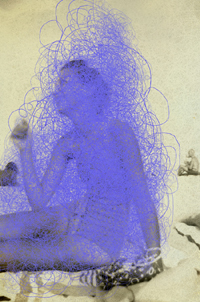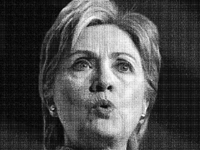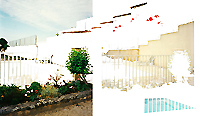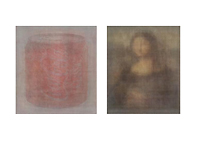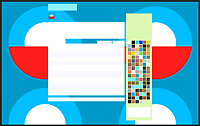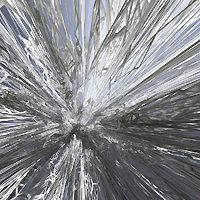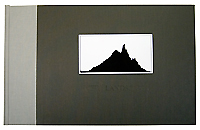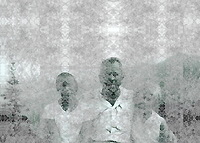| Syntax |
||
| March 27 – May 10, 2009 This group exhibition brings together photography and related media that visualizes and addresses digital information and systems. The artists consider or create new forms of syntax via digital processing or selection.
The PRC participated in the first Cyberarts Festival in 1999 by hosting a digitally-themed version of our annual juried exhibition; this year, the PRC pays homage to these beginnings by meditating on the pixels and programs themselves. Below you will find an essay on Syntax and links to individual artist pages, which include all images and statements from the exhibition. Click here to schedule a tour. "I eagerly await new concepts and processes. I believe that the electronic image will be the next major advance. Such systems will have their own inherent and inescapable structural characteristics, and the artist and functional practitioner will again strive to comprehend and control them.”1 - Ansel Adams, 1981 This group exhibition considers artists and photographers that address the language of digital information—its meaning and aesthetics—in their work. Many of the artists in Syntax mine the popular realm and include internet image searches, social and networking sites, or the media in their process-oriented arsenal. Others look to the natural world, seeking to envision a twenty-first-century digital version of nature or mathematical equations to visualize using 3D rendering programs. Still others consider the basic building block of the digitally-rendered image—the pixel—or the essence and ontology of a programmatically-produced product. As one of the artists in the exhibition Benno Friedman states, “In looking at a photograph, how many pixels can be removed or altered before the familiar becomes the unrecognizable? At what point does a photograph cease to be?” Syntax seeks to deconstruct digital language, but does not leave us down a metaphorical worm hole. After the requisite parsing and processing, the artists actively resurrect and recombine their raw materials using programs such as Photoshop, flash, or self-authored code. One can certainly imagine if Ansel Adams were alive today that he would enjoy seeing his photographs realized as histograms as well as the digital revolution as a whole. Syntax is held in conjunction with the region-wide 2009 Boston Cyberarts Festival (April 24 – May 10). This is the fifth time the PRC has joined close to forty regional venues in participating in this biennial festival celebrating art and technology. More information on all of the exhibitions and events can be found online at bostoncyberarts.org. Interestingly enough, the PRC participated in the very first Cyberarts Festival in 1999 by hosting a digitally-themed version of our annual juried exhibition. Selected by International Center of Photography's Curator of Digital Media, Edward Earle, and the PRC's Sara Dassell, the works broadly interpreted the genre of “new media," but in most cases the artists explored the translation of the photographic image into the then new medium of computer-generated prints. Duly noting Boston's cutting-edge heritage—which earned the area around Route 128 the moniker “the fertile crescent”—the jurors stated in the PRC newsletter, “The elegantly printed Iris Ink Jet image on a fine rag paper is the 1990's answer to the 1890's platinum print.”2 It seems appropriate then, that ten years after the first Cyberarts festival, the PRC should return to beginnings and meditate on the syntax of digital language itself. 1.) Ansel Adams, The Negative (Boston: Little Brown and Company, 1981), Introduction.
Patti Ambrogi “[‘Cover Girls'] explores the digital pixel that seductively creates the illusion in the photograph, and our easy surrender of belief as we read photographs. The series proposes to align the language of technique and the construction of the representation to build deeper significations within the structure of the photograph itself.” Patti Ambrogi tackles iconic images of women in media in her series “Cover Girls.” Frames of video and stills are distilled to their essence and re-animated using graphic icons. These elements are specifically chosen so as to comment upon the person or situation. Each pixel, Ambrogi explains, “is re-signified as an image”—Barbie trinkets, for example, make up Jon Benet and flower parts congregate into Marilyn. (In the image reproduced here, Martha is composed of 50,000 gingerbread cookie crumbs, one for each dollar she profited from insider trading.) These pieces are then represented as large canvases and flash animations, mesmerizing the viewer with looped re-presentations of ideological information. Ambrogi is an Associate Professor at the School of Photographic Arts at Rochester Institute of Technology. She holds an MFA from the Visual Studies Workshops in Rochester, NY. Recently, her work has been shown at Light Work in Syracuse, NY and the Pyramid Gallery in Rochester, NY. Additionally, her video pieces have been shown extensively at conferences, including the Society of Photographic Education, Visual Communications, and the International Conference on the Arts and Humanities. She is the founder of the Media Café at RIT, a digital arena that showcases and promotes the production of temporal work that crosses disciplines and media.
Leigh Brodie “My work takes the form of digital images, videos, and installations. With them, I examine both the creation and translation of digital information. I am fascinated by how the digital makes our infinite world finite and transforms lived experience into the discrete.…I approach the idea of digitality from both sides of the equation looking at how information is encoded and decoded.” – LB Leigh Brodie experiments with digital information—how it is presented, translated, and outputted. Most of her work involves information that is cut up and passed through some sort of instruction set or program, to then be assembled again in an entirely novel manner. In the series on display at the PRC, "Pixels Enlarged and Replaced," she presented her husband's cousins and grandmother with photographs of themselves and conducted a survey regarding their reaction to the image. Each pixel in the image was either reduced or enlarged based upon her family members' answers (how positively or negatively they responded) and then the pixel was put back in the order they were removed, in rows or in a clockwise spiral. Beautiful in their decay, the results recall the degradation of an image when incorrectly transmitted or processed. Brodie is a 2007 MFA graduate of the School of the Museum of Fine Arts, Boston. She received an NEA Grant in Extending Creativity and Digital Media in 2008 as well as the SMFA's Karsh Prize in Photography in 2006. Her recent exhibitions include showings in the Texas Biennial at Women and Their Work in Austin, TX; Double Take at Eyebeam in New York, NY; Pixel Pops: Wide Open at the Krannert Museum at the University of Illinois at Urbana-Champaign; and Circuitry at Axiom Gallery in Boston.
“Software is today's magic wand, allowing all of us to become wizards …[but] what is a photograph? Instead of eliminating all of the scratches and dust marks on a photograph, one could choose to eliminate everything but the scratches and dust marks; the result would be no less a photograph.” – BF “Although these contemporary landscapes may be composed of gifs and jpegs, bits and bytes, as opposed to the trees, bushes, and buildings of conventional landscape, they are nonetheless a new arena laden with visual stimuli within which we move—scrolling, moving backwards or forwards, opening and closing new windows on new imagery and new paths.” – MG To create the images in “Go ogle,” Gould created a code (for those curious, a combination of Perl, Python, and ImageMagick) that automatically grabs and downloads the 100 most recent images from a search term inputted to google.com. It then averages the pixel size and color and then resizes and flattens the results. The end products, what Gould calls a cross between “Boolean logic and the popular imagination,” are usually amorphous, but occasionally a recognizable image emerges from the digital ether. Often, Gould tries to test the limits of the search by performing searches that “don't work” in interesting ways, such as seen in the combination “landscape + photograph.” Two iterations of the “Go ogle” series will be shown: one which charts the change of four words, such as “mugshot,” over the course of four months and a selection of images featuring two or more words, such as “mona + lisa” or “img + 1172.” Gould is a 2005 MFA graduate of the University of Massachusetts at Dartmouth and currently teaches at Bowdoin College in Brunswick, ME. Included in the Rhizome Net and New Media Collection at New York's New Museum, she has shown at a variety of international venues. Most recently, she was featured in the 2008 Biennial Exhibition at the Center for Maine Contemporary Art in Portland, ME. “The Internet provides individuals, groups, and organizations a worldwide multimedia forum for expression, promotion, branding, and sales. My work uses deconstructed abstractions of actual web sites to create new compositions in a removed, off-line environment.” – BP Brian Piana creates abstracted versions of both static web sites as well as flash animations that reference the experience of surfing the Internet. Barack's Twitter takes as its source then candidate Obama's twitter page, an example of the President's deep use of social media. (In a twist of fate, both Obama's and Britney Spears's twitter pages were recently hacked in January.) In another print, Shopping for a Designer Wallet (2005 | 2007), we see two page-by-page renderings of a common retail quest performed two years apart. In one of his animations, Browsing for Dannielle Tegeder, Piana playfully abstracts the much-repeated activity of researching online. Creating in effect a new media “map,” he includes variations on the referenced site's design and the browser's path in his formal arrangements. Forms pop up and are repeated, sounds blink and blip, resulting in striking new visual narratives. Piana holds an MS in Visualization Sciences from Texas A&M and an MFA in Photography and Digital Media from the University of Houston, where he currently teaches. He has shown at several national juried shows at a variety of venues, including the Phoenix Gallery and SOHO20 in New York, NY and the Art Center at Stephen F. Austin State University in Nacogdoches, TX. In 2008, he showed extensively with Fotofest in Houston, TX, including their Biennial Fine Print Auction and the group exhibition Mechanical Perception. “I am a scientist and an artist. For scientific research, I develop numerical methods and write computer programs that simulate natural phenomena—usually fluid motion. These programs, being very expensive and complex data manipulators, can be retasked with wholly artificial initial conditions to create never-before-seen structures that still contain familiar, natural elements.” – MS Blurring the line between code and art, for each and every piece, Stock writes a new program that often addresses some element of fluid dynamics. These sometimes take the computer up to a week to process and the result is then pulled into a 3D rendering program called Radiance. In a sense, this action could be seen as using a photo studio of gigantic proportions: Stock can choose the direction of the light, select the focal plane and f-stop, and light with the radiance of 500 suns. His newest pieces reach further into the metaphorical and are akin to philosophers' thought experiments. Midnight in the Bathtub of Good and Evil, for example, is a representation of a battle between armies of fluids cast in mathematical terms. In Inside the Bomb, we are transported to the interior of a bomb to witness the frenetic results of an explosion, mere milliseconds after it went off. A densely woven thicket of black, white, and gray lines, the piece Perpetuity? questions the directionality of time. Stock holds a PhD in Aerospace Engineering from the University of Michigan. A member of the Collision Collective, he has shown locally at MIT's Stata Center in Cambridge and Axiom Gallery in Jamaica Plain. Stock also shows extensively internationally, participating in several SIGGRAPH events, galleries, and traveling exhibitions. “My desire to re-envision Ansel Adams's landscapes comes from an interest in both the technology of imaging and the types of information with which images can provide us. Not only can we use photographs to interpret the landscape, we can use methods of interpreting photographs to envision new concepts of the landscape. As new photographic technologies emerge, so too emerge new ways of seeing information and, thus, seeing images." – LS
“I am curious about the perceptual conversation that occurs when the screen is negotiated to see the underlying image, and vice versa. In short, I am attracted to the way in which the drawn screen holds the viewer at a certain distance from the image.” – MS Matthew Swarts is fascinated by mark making—from human, computer, to somewhere in-between. While his previous work dealt primarily with the internet—showcasing odd internet word searches—Swarts newest series hits closer to home and engages the mark of his own hand and found graphics with an old family album. After his grandfather passed away, Swarts began making high resolution scans of doodles and patterns which he then transformed in Photoshop and overlaid over family photographs. The resulting aesthetic lattices both invite and repel the viewers, creating a dense and complex matrix through which to confront issues of memory. After majoring in philosophy at Princeton, Swarts earned his MFA from Massachusetts College of Art and Design in 1997. His work has been included collections such as the DeCordova Museum of Art, Lincoln, MA; Museum of Fine Arts, Boston, MA; Library of Congress, Washington, DC: and the Polaroid Collections. A recipient of a Light Work residency, he currently teaches at Ramapo College of New Jersey. |
www.lensless.net
|
|
|
|
||
|
|
||

